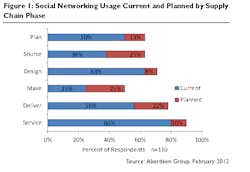“People in both financial markets and baseball operate with beliefs and biases. To the extent you can eliminate both and replace them with data, you gain a clear advantage.” — Michael Lewis, Moneyball
Knowing that a supply chain disruption can cause revenue leakage and market share loss, supply chain managers have tweaked every angle and measured every corner to speed delivery and improve production. As supply chains become more complex and pressures increase, supply chain managers need to ensure that they have the right information to compete. The customer perspective has come to the forefront as an important element that has been missing.
In the past managers sought to understand customers using focus groups and marketing studies, but social analytics has emerged as a new and powerful tool. Social analytics has begun to revolutionize the actionable information available to the decision makers charged with supply chain management. Major League Baseball (MLB) can provide insights for supply chain managers to learn about the impact of social analytics.
Every summer since 1933 MLB has held an All-Star Game where the National League and American League put their finest players on display for the ultimate exhibition game. The All-Star game has become a highly popular baseball event, second only to the World Series. What makes this game unique is that fans vote on who will play the starting positions for each league. The players and managers also get to vote on positions such as pitchers and backup players. Then there is one additional player who is voted in by fans after the list of 33 players for each league is announced. This is a true collaboration to select the best and most popular players and to create a great baseball exhibition for the fans to watch and enjoy – in some respects, it was an early form of social media.
Baseball fans love being part of the All-Star Game experience because their opinion matters on the players who take the field. Likewise, consumers want their opinions about products and services to be heard and to feel like they make an impact. While the desire to be heard is universal and long-standing, only recently has technology evolved to provide consumers with robust tools to do so. With the social media revolution now deeply rooted into our everyday lives and a staple of our culture, it is has become much easier to express opinions through e-mail, social networking sites, blogs, text, chat, and yes, even using a telephone to talk to someone.
In the last decade social analytics has risen to the forefront in the business of baseball, from planning a team and creating a roster to evaluating performance on the field and getting the most from the club payroll. In similar fashion the impact of analytics is being harnessed to improve supply chain management performance. Social feedback loops provide a huge advantage through understanding customers and how they perceive a company’s products or services. This combination of social, analytics, cloud computing and mobility has enabled unprecedented consumer influence, starting in consumer-centric industries like retail, but now permeating even business-to-business companies and sectors like heavy manufacturing.
For many years marketing and advertising groups have conducted polls to gauge consumer opinions, and over the last few years they have learned to incorporate social analytics as well. Marketers have taken real-time data and learned to measure advertising campaign effectiveness, understand customer information needs, and determine brand perception. This includes not only historical customer purchase data, but also purchase suggestions and predictions.
Swinging for the Fences
The Oakland Athletics were highlighted in the book (and movie) Moneyball for taking one of the lowest payroll teams and outperforming almost every other major league team. They did this by focusing on analytics and statistics. They took much of the gut feel of scouting out of the evaluation with regards to what constitutes a useful player and competitive team. Instead, they relied on measurable and tangible data – they applied analytics to find bargains to build their roster. They did this by focusing on key performance indicators like price for foot speed, on-base percentage and several other factors. These analyses helped them move beyond players’ past performances and begin to see patterns that helped predict how a player might perform in the future.
According to a recent study on supply chain progress, those companies that have both strong visibility and analytics capabilities are almost twice as likely to be in the top 20% of business growth than firms that do not. Social analytics has the ability to help supply chain managers make critical adjustments, maintain proper inventory levels, monitor order management and decrease returns, which in turn help control costs and improve customer satisfaction. Like the Oakland Athletics, supply chain managers have the opportunity to measure data and apply analytics from customer sentiment about their products and services. Social analytics is even more critical for companies that sell through indirect channels, as they lack as much direct access to the end customer.
Supply chain management (SCM) professionals feel more pressure than ever to get the right products to the right place, at the right time, at the right cost. The right place can be on the other side of the world and the right time often means now, given increased consumer needs for immediate gratification. To manage this feat, leaders in SCM are also harnessing social analytics and its power to predict trends in product demand. Using the baseball analogy, product lines can be compared to players on a baseball team. Analytics can help supply chain professionals understand how the customers think about products and how they perform in specific situations.
Using social analytics, SCM practitioners can discover when there are product defects or when consumers experience problems in product performance. For example, consumers may complain about usability of a garden trowel handle and how it slips in the hand during use. This rapid feedback can provide an early warning for a manufacturer to redesign the handle with a non-slip cover to prevent possible injuries. While customer service may have traditionally been the only function to hear about this (or care), savvy supply chain professionals can use this information to adjust future demand and supply plans.
Social analytics can also help discover basic product advantages and disadvantages. An automaker might use analytics to find that consumers prefer cars with tan leather interior in the U.S. Southwest, while northern states prefer dark fabric. This type of timely feedback allows more market signals to be more directly and rapidly assimilated in the plan, ultimately dampening the bullwhip effect, maximizing order fill rates, and reducing excess inventory.
A recent report from industry analyst Aberdeen Group suggests that “service” is by far the largest supply chain stage using social data, and this makes sense given it is the closest and most visible to the end customer. However, “plan” and “deliver” also rate highly. The report goes on to say demand management, order fulfillment and inventory management each have significant potential for impact by social analytics (Figure 1).
A Combination of Art and Science
It is crucial to have the right people to interpret and analyze the data, and supply chains must be agile enough to take advantage of whatever insights that analytics can provide. Supply chain managers can capitalize on the social media revolution, as long as they recognize this as a combination of art and science. Better trend and demand forecasts come from combining social analytics from R&D, sales and marketing, product engineering, and distributors to ensure better forecasting of trends and demands.
Mary Schalett, president of Transworld Data, recently wrote of a retail supply chain manager who just completed consolidations of their retail and e-tail warehousing, focused on improving early collaboration with sales and marketing. Customers want immediate gratification, and they don’t want to wait on back orders. Companies need to take advantage of trends like social media and eke out whatever advantage they can get from improved forecasting and meeting demand. Ultimately, social analytics is about using social media to increase predictability for key operational metrics.
Back to Moneyball: “Baseball—of all things—was an example of how an unscientific culture responds, or fails to respond, to the scientific method” (from the preface by author Michael Lewis). Sound familiar? Supply chain management used to be considered in this manner, until gradually operations research and statistical techniques brought more order from the chaos. Add social media to the mix, and similar challenges reemerge, as social is viewed as unstructured and unscientific at the individual level. It is only when the data is aggregated and properly structured that useful patterns emerge. Companies need to use the right data, develop relevant models, make informed decisions and then measure the results.
For example, baseball used to rely on scouting and a coach’s impressions about a player. Decisions were made based on questionable inputs, glamorous metrics like home runs, and plain old gut feel. Now tangible and measurable attributes have been added to the equation to improve the data used to make decisions. Enterprises can also learn from this and apply social analytics to develop better data sets to help them make the right decisions about their supply chain. Rather than devote more resources to the supply chain, the focus should be on working smarter and seeing more bottom-line impact by using available information.
“Each year the Oakland A’s seemed to be more the financial underdog and each year they won more games. Maybe they were just lucky. Or maybe they knew something other people didn’t.”Companies can become more competitive and perhaps achieve All-Star status in their own right by improving supply chain performance with social analytics.
Jeff Kavanaugh is managing partner, Infosys Manufacturing & High-Tech Consulting.




